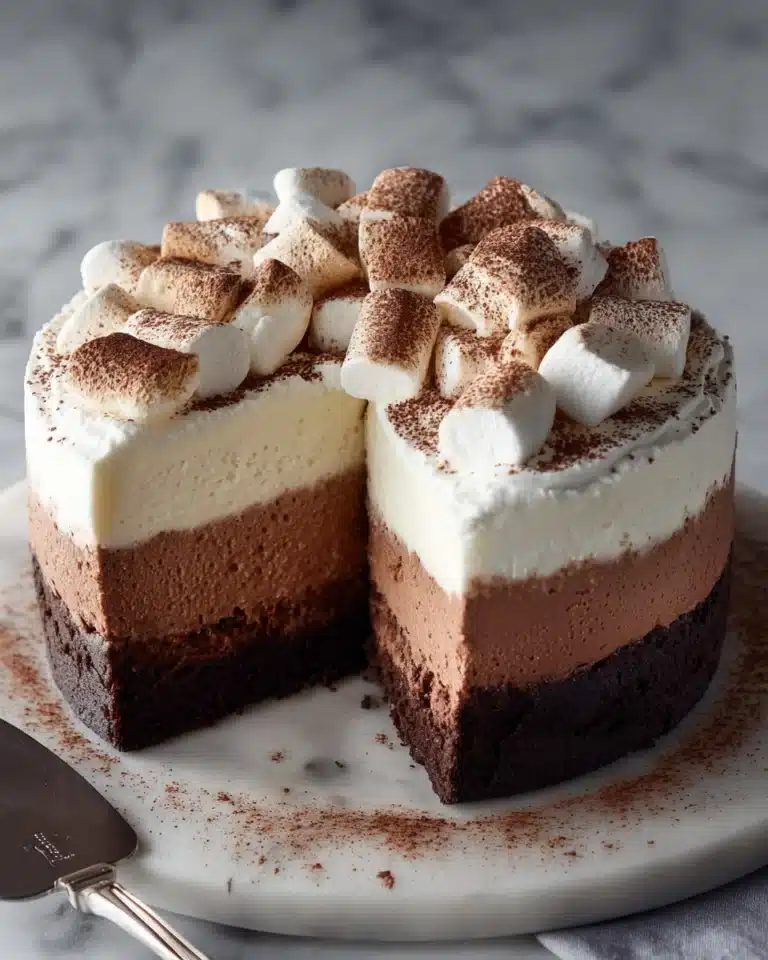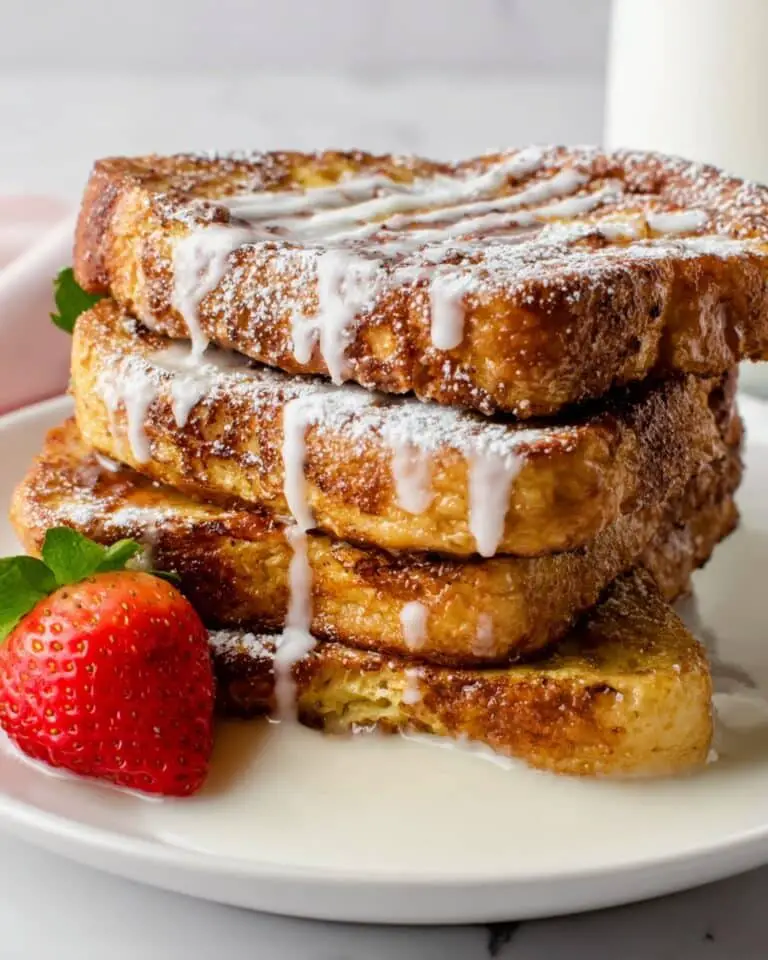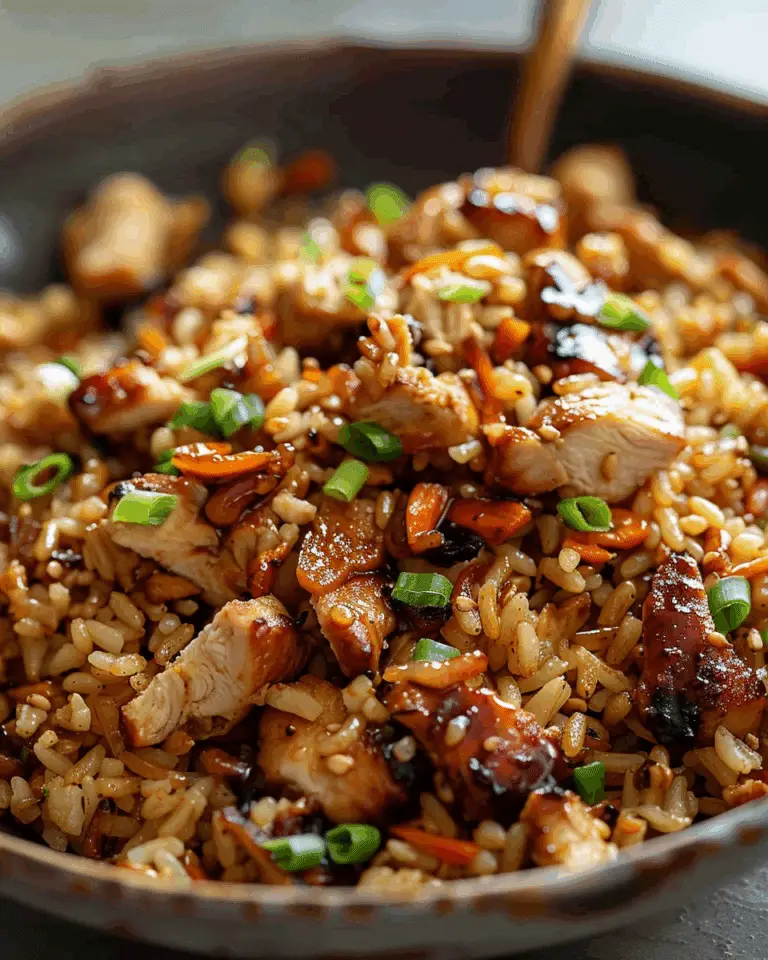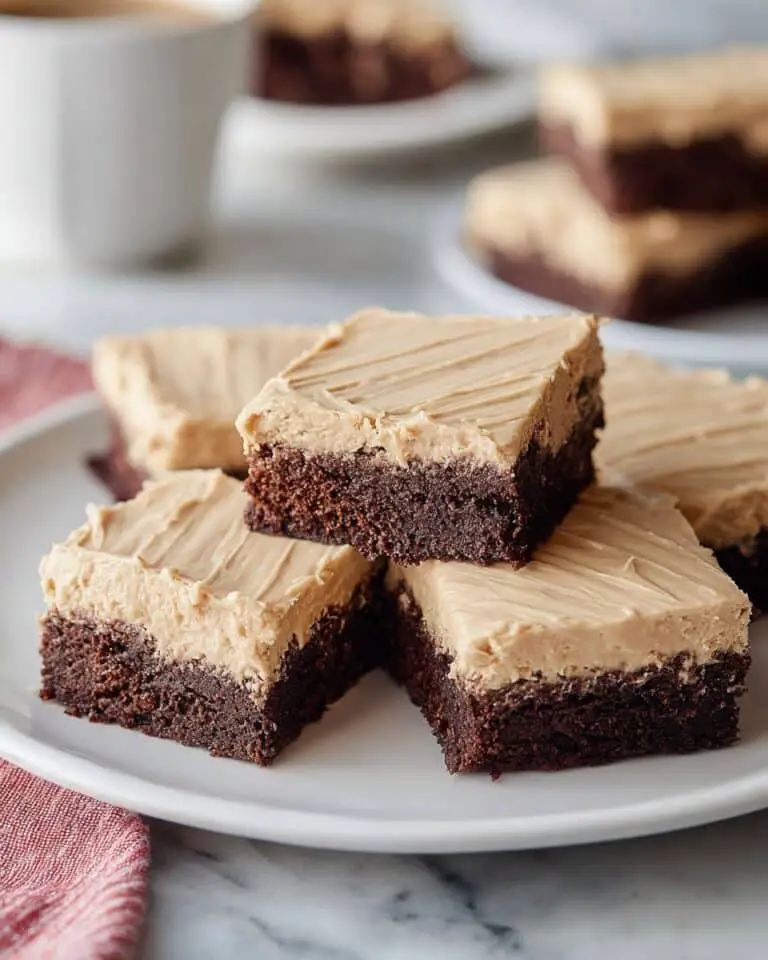If you’re craving a comforting, flavorful dish that warms your soul and fills your kitchen with irresistible aromas, this Japanese Chicken Curry Recipe is an absolute must-try. Combining tender chicken thighs, melt-in-your-mouth vegetables, and a perfectly spiced curry roux, this dish strikes a wonderful balance of sweet and savory with just a few secret ingredients like grated apple and honey. It’s not just a meal; it’s a delightful experience that invites you to savor every bite and share the joy of homemade Japanese comfort food with your loved ones.
Ingredients You’ll Need
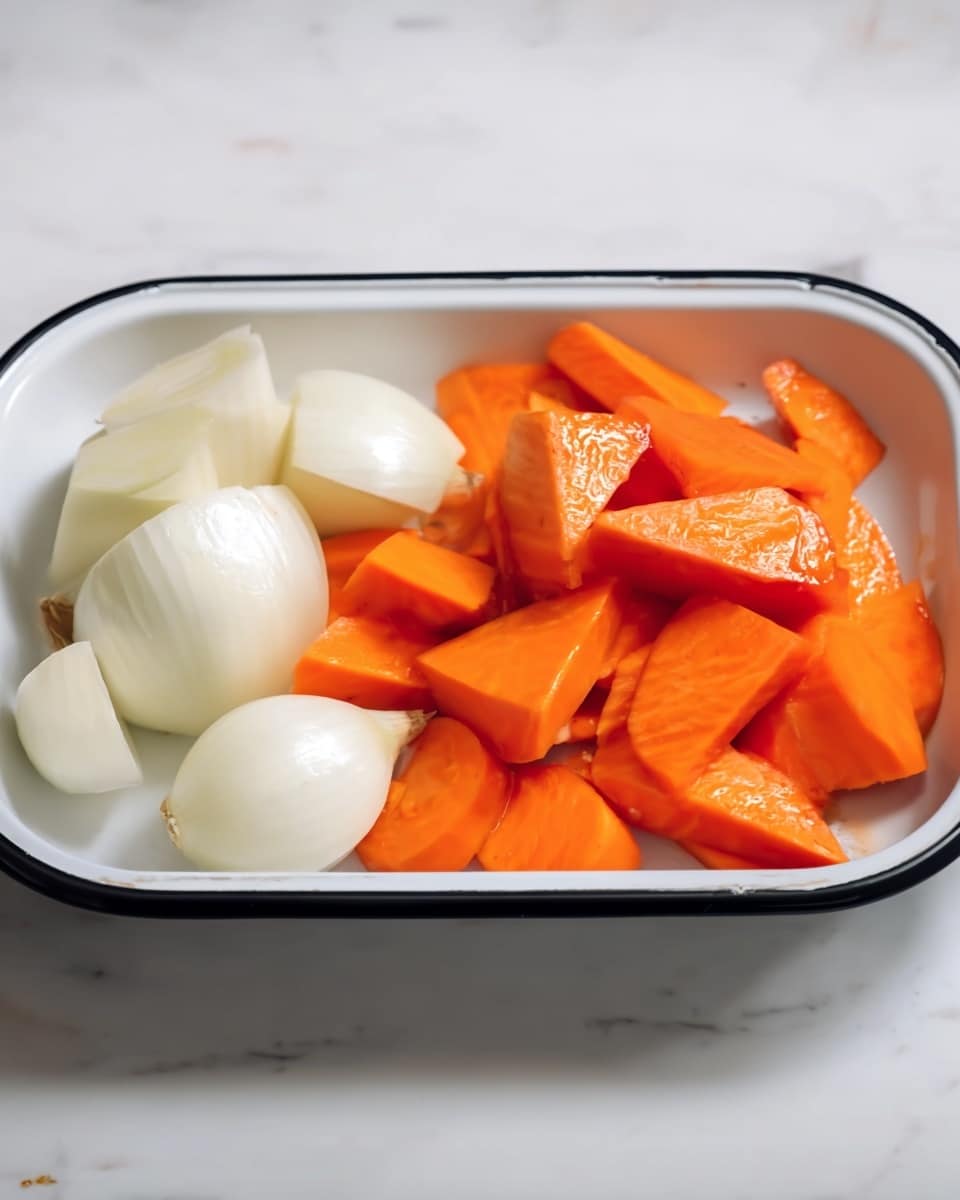
Getting the ingredients just right is the first step to nailing this Japanese Chicken Curry Recipe. Each one plays its part, from the sweetness of the apple to the hearty potatoes, creating layers of texture, flavor, and color that make this curry so special.
- 2 large onions (1.5 lb, 670 g): Adds sweetness and depth as they soften and caramelize gently.
- 2 carrots (6.7 oz, 190 g): Cut into rolling wedges to soak up all those lovely curry flavors quickly.
- 3 Yukon gold potatoes (15 oz, 432 g): Hold shape beautifully, providing hearty, creamy texture.
- 1 tsp grated ginger: Offers a gentle warmth and slight zing that brightens the dish.
- 2 cloves garlic: Builds savory depth and balances the sweetness.
- ½ apple (6 oz, 170 g): Grated for natural sweetness and a subtle fruity undertone.
- 1½ lb boneless, skinless chicken thighs: Perfectly tender and juicy, the star protein of this curry.
- Freshly ground black pepper: Adds a mild spice and aroma.
- 1½ Tbsp neutral oil: For sautéing onions and chicken without overpowering other flavors.
- 4 cups chicken stock/broth: Rich base that melds all the ingredients together.
- 1 Tbsp honey: Sweetens and rounds out the curry’s flavor profile.
- 1 Tbsp soy sauce: Brings umami and depth to the sauce.
- 1 Tbsp ketchup: Adds a tangy sweetness that balances the spice.
- 1 package Japanese curry roux (7–8 oz; 200–230 g): Essential for that authentic curry thickness and spice blend.
- 8 servings cooked Japanese short-grain rice: The perfect fluffy bed for soaking up the rich curry.
- Fukujinzuke (optional): Japanese red pickled vegetables to brighten each bite with a crunchy, tangy contrast.
You’ll find the full ingredient list, instructions, and print option in the recipe card below.
How to Make Japanese Chicken Curry Recipe
Step 1: Prepare Your Ingredients
Start by prepping all your fresh ingredients thoughtfully. Cut the onions into thick wedges to keep a satisfying texture, slice the carrots into rolling wedges so they soak up more flavor, and quarter your Yukon gold potatoes after soaking to remove excess starch. Grate the ginger and apple for that subtle sweetness and warmth, and mince the garlic finely for an even distribution of flavor. Finally, cut the chicken thighs diagonally into bite-sized pieces to maximize tenderness and quick cooking.
Step 2: Sauté Onions, Garlic, and Ginger
Heat the neutral oil in a large pot over medium heat to create your flavor foundation. Add the onions and sauté them without stirring too often, allowing them to develop a gorgeous golden hue that adds richness to your curry. Once tender and translucent, stir in the garlic and ginger, letting their aromas fill your kitchen and blend beautifully with the onions.
Step 3: Brown the Chicken
Toss in the chicken pieces seasoned with freshly ground black pepper and cook until the exterior loses its pink color. This seals in the juices and ensures every bite of your curry is juicy and flavorful. Be mindful to lower the heat if the onions begin browning too fast so the flavors develop evenly without burning.
Step 4: Add Stock and Seasonings
Pour in the chicken stock or broth, letting it gently combine with your other ingredients. For a lighter sodium option, feel free to substitute half the broth with water. Stir in the grated apple, honey, soy sauce, and ketchup, which together bring a complex sweetness and umami that elevate the curry to something truly special.
Step 5: Add Vegetables and Simmer
Introduce the carrots and potatoes to the pot now, ensuring the liquid just covers them to prevent a watery curry. Cover and simmer on medium-low heat, stirring occasionally. Skim any foam for a clear broth and cook until the vegetables are tender enough for a wooden skewer to pass through effortlessly. This creates the perfect tender bite without losing shape or texture.
Step 6: Incorporate the Curry Roux
Turn off the heat and gradually add the curry roux cubes, dissolving them in ladlefuls of the cooking liquid before stirring back into the pot. Return the pot to low heat, stirring frequently to avoid burning, and let the curry thicken into that familiar silky texture that defines Japanese chicken curry. Adjust consistency with water if needed, and finish with salt if you’re using homemade roux.
How to Serve Japanese Chicken Curry Recipe
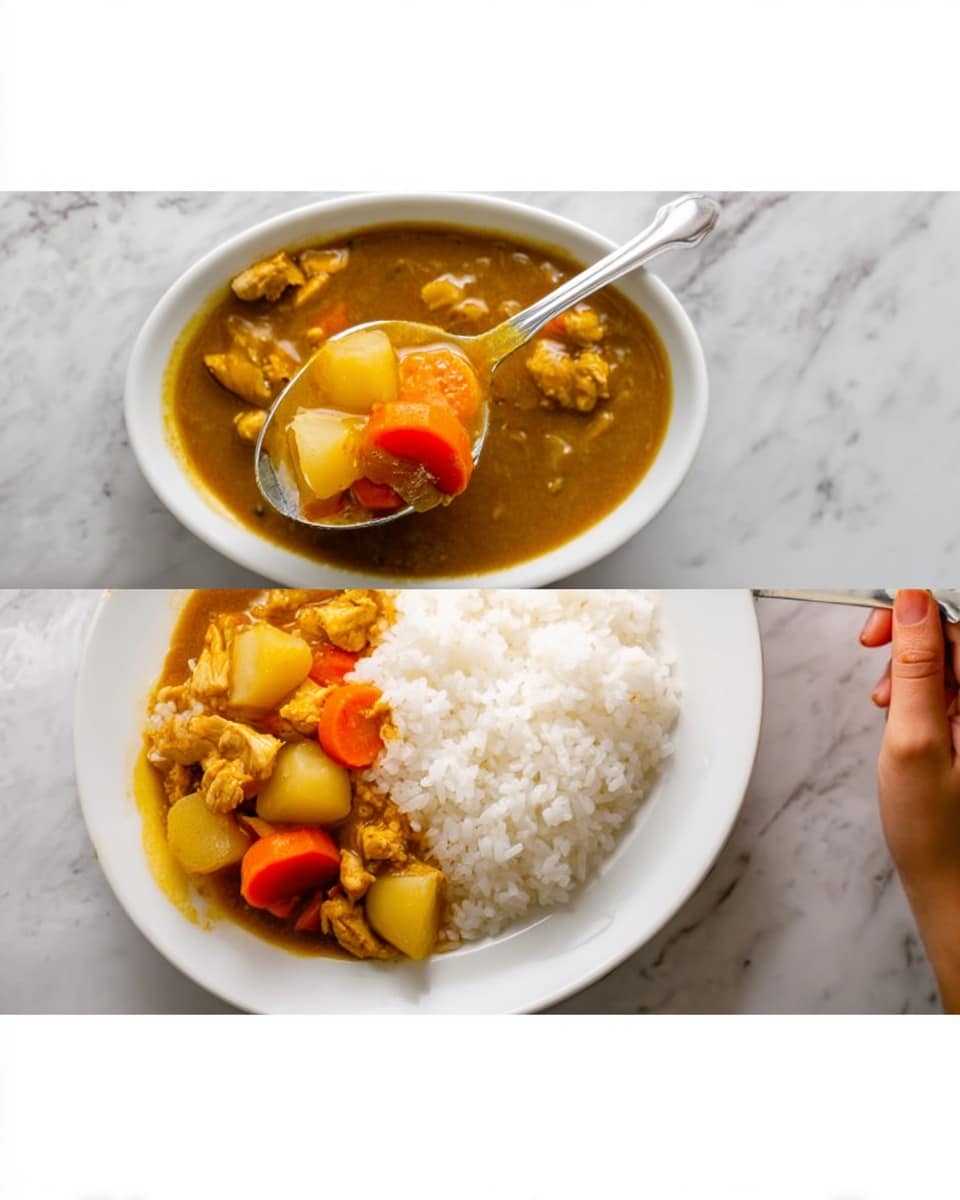
Garnishes
Fukujinzuke, the vibrant Japanese red pickled vegetables, add a delightful crunchy and tangy contrast that cuts through the richness of the curry beautifully. Sprinkling a little on the side of your plate or on top is a tradition that brightens each spoonful and elevates the experience.
Side Dishes
This curry pairs wonderfully with warm, steamed Japanese short-grain rice, which lovingly absorbs the sauce with each bite. If you’d like to add extra texture and freshness, a simple green salad or a side of steamed greens like bok choy can complement the dish perfectly.
Creative Ways to Present
For a stunning presentation, serve your Japanese Chicken Curry in a rustic bowl topped with a sprinkling of chopped green onions or toasted sesame seeds. For a family-style dinner, present the curry and rice separately and let everyone serve themselves to create a cozy and interactive meal vibe.
Make Ahead and Storage
Storing Leftovers
Store leftover Japanese Chicken Curry Recipe in an airtight glass container to avoid any staining or lingering odors. It stays fresh in the fridge for up to three days, making it an excellent option for quick lunches or easy dinners later in the week.
Freezing
This curry freezes well, but to keep the best texture, remove the potatoes before freezing as they can become mushy. Freeze the sauce and chicken separately in a sealed container for up to one month. Thaw in the refrigerator before reheating for optimal flavor and texture.
Reheating
When reheating, add a splash of water to loosen the thickened sauce and prevent burning. Warm gently over low heat, stirring frequently until heated through. If the sauce feels too thin, let it simmer uncovered to reduce to your preferred consistency.
FAQs
Can I use chicken breast instead of thighs in this Japanese Chicken Curry Recipe?
Absolutely! Chicken breast can be used if you prefer leaner meat, but be careful not to overcook it as it can dry out. Thighs are recommended for their juiciness and tenderness, which suit this slow-simmered curry perfectly.
What can I substitute for Japanese curry roux if I can’t find it?
If you can’t find Japanese curry roux, you can make your own using a blend of curry powder, flour, and butter, or try brands online. Keep in mind the flavor profile might vary slightly, but the homemade roux can be just as delicious with a bit of experimentation.
Is the grated apple necessary in this Japanese Chicken Curry Recipe?
The grated apple adds a subtle sweetness and fruity depth that balances the spices and savory elements, making it an essential secret ingredient. However, if unavailable, a bit of grated pear or a small amount of honey can help recreate that balance.
Can this Japanese Chicken Curry Recipe be made vegetarian?
Yes! Use vegetable broth instead of chicken stock and substitute the chicken with hearty vegetables like mushrooms, tofu, or eggplant. The curry roux and spices will still deliver the rich flavor this dish is known for.
How long does the curry keep its flavor after making?
Japanese Chicken Curry Recipe often tastes even better the next day as the flavors have more time to meld together. It stays flavorful and delicious for up to three days refrigerated, making it perfect for leftovers.
Final Thoughts
I truly hope you give this Japanese Chicken Curry Recipe a spot in your cooking repertoire. It’s more than just a delicious meal; it’s the taste of warmth, comfort, and a little bit of magic from my kitchen to yours. Enjoy the process, savor every spoonful, and don’t forget to share it with those you love!
PrintJapanese Chicken Curry Recipe
This Japanese Chicken Curry recipe offers a rich, flavorful curry made with tender chicken thighs, onions, carrots, and potatoes simmered in a savory sauce enhanced with ginger, garlic, apple, honey, soy sauce, and ketchup. It is thickened with Japanese curry roux and served alongside steaming short-grain rice, making for a comforting, hearty meal perfect for family dinners.
- Prep Time: 25 minutes
- Cook Time: 45 minutes
- Total Time: 1 hour 10 minutes
- Yield: 8 servings
- Category: Main Course
- Method: Stovetop
- Cuisine: Japanese
Ingredients
Vegetables & Fruits
- 2 large onions (1.5 lb / 670 g)
- 2 carrots (6.7 oz / 190 g)
- 3 Yukon gold potatoes (15 oz / 432 g)
- 1 tsp grated ginger
- 2 cloves garlic
- ½ apple (6 oz / 170 g)
Meat
- 1½ lb boneless, skinless chicken thighs
- Freshly ground black pepper, to taste
Liquids & Condiments
- 1½ Tbsp neutral oil (for cooking)
- 4 cups chicken stock or broth (can substitute half or all with water for lower sodium)
- 1 Tbsp honey
- 1 Tbsp soy sauce
- 1 Tbsp ketchup
Other
- 1 package Japanese curry roux (7–8 oz / 200–230 g)
- 8 servings cooked Japanese short-grain rice
- Fukujinzuke (Japanese red pickled vegetables) – optional
Instructions
- Gather Ingredients
Collect all the vegetables, chicken, Japanese curry roux, and seasonings. Ensure you have ginger, garlic, apple, honey, soy sauce, and ketchup ready, which are key for enhancing the curry’s flavor.
- Prepare Vegetables
Cut onions into thick wedges to maintain texture during cooking. Peel and cut carrots into rolling wedges (rangiri style) to create more surface area. Peel and quarter potatoes, soaking them in water for 15 minutes to remove excess starch, which helps them hold shape during cooking.
- Prepare Aromatics and Fruit
Grate 1 tsp ginger with juice and mince 2 garlic cloves finely. Peel and core the apple, then grate it for sweetness and depth of flavor.
- Prep Chicken
Trim excess fat from chicken thighs and cut them into bite-sized diagonal pieces (sogigiri) to increase surface area for faster cooking. Season with freshly ground black pepper.
- Sauté Onions
Heat 1½ Tbsp neutral oil in a large pot over medium heat. Add onions and sauté gently without stirring too often, cooking for about 5 minutes until translucent and tender. For more flavor, continue cooking an additional 5 minutes to deepen color.
- Add Garlic and Ginger
Add minced garlic and grated ginger to the pot, stirring to combine well with the onions.
- Cook Chicken
Add chicken pieces to the pot, stirring frequently. Cook until the chicken turns opaque on the outside. If onions brown too quickly, reduce heat to medium-low.
- Add Liquids and Flavorings
Pour in 4 cups chicken stock or broth (or substitute with water as desired). Stir in grated apple, honey, soy sauce, and ketchup to infuse the curry with sweet and umami notes.
- Add Vegetables
Add carrots and Yukon gold potatoes. If using russet potatoes, add them later in the last 15–20 minutes of cooking to prevent disintegration. Ensure the broth barely covers the ingredients to avoid excess liquid.
- Simmer the Curry
Cover and simmer on medium-low heat for 15 minutes, stirring occasionally. If ingredients are fully submerged, simmer uncovered. Skim off any scum or foam from the surface using a fine-mesh strainer. Continue cooking until carrots and potatoes are tender when pierced with a wooden skewer.
- Add Curry Roux
Turn off heat. Dissolve 1-2 cubes of Japanese curry roux in a ladle of cooking liquid, then stir into the pot. Repeat until all roux cubes are incorporated.
- Thicken the Curry
Simmer uncovered on medium-low, stirring frequently to prevent sticking or burning, for 5–10 minutes until the curry thickens. Add water to adjust thickness if necessary. Taste and season with salt if using homemade unsalted roux.
- Serve
Serve the Japanese chicken curry hot with steamed Japanese short-grain rice on the side. Optionally, garnish with fukujinzuke (Japanese red pickled vegetables) for authentic flavor.
- Store Leftovers
Store leftover curry in airtight containers in the refrigerator for up to 3 days or freeze for up to 1 month (remove potatoes before freezing to preserve texture). Defrost in the refrigerator before reheating.
- Reheat
To reheat, stir in ½ cup water or more to loosen thickened curry sauce, then gently warm on low heat, stirring often to prevent burning. If the sauce is too thin, simmer uncovered to reduce.
Notes
- For a lower sodium curry, substitute chicken stock with water or half stock and half water.
- Yukon gold potatoes hold shape better; russet potatoes may disintegrate if cooked too long, so add later if using.
- Cut chicken diagonally (sogigiri) to increase surface area and speed cooking.
- Do not over-stir onions during sautéing to achieve flavorful golden color.
- If using homemade curry roux, salt to taste at the end, as it typically lacks salt.
- Leftover curry thickens as it cools; add water before reheating to prevent burning.
- Fukujinzuke is optional but adds authentic Japanese pickled flavor.


